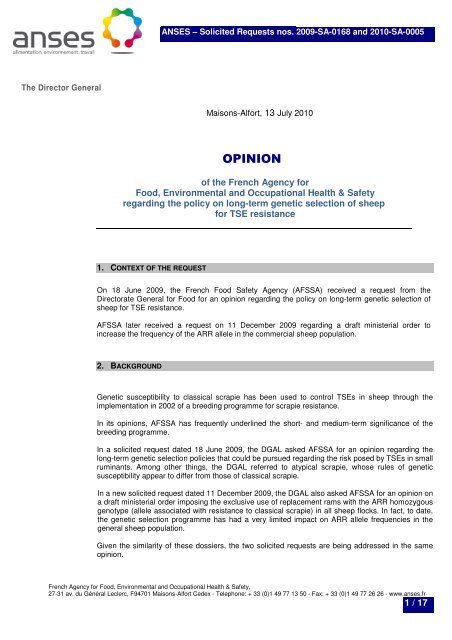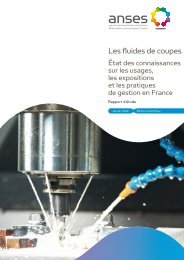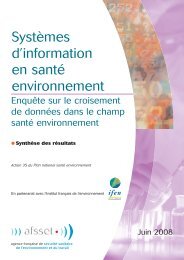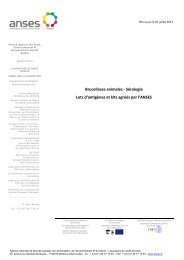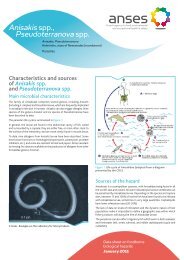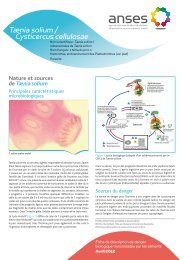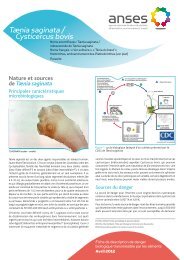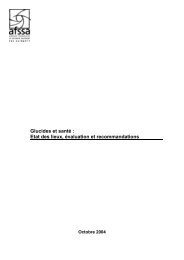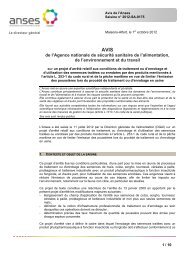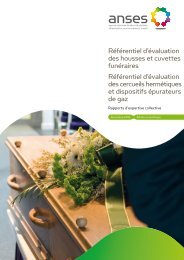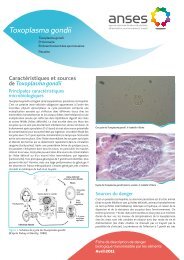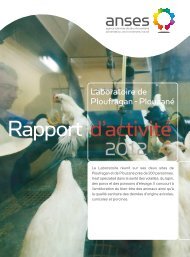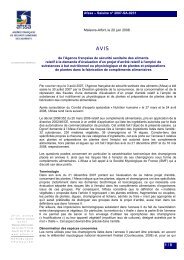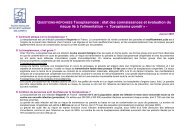Opinion of the French Agency for Food, Environmental and ... - Anses
Opinion of the French Agency for Food, Environmental and ... - Anses
Opinion of the French Agency for Food, Environmental and ... - Anses
Create successful ePaper yourself
Turn your PDF publications into a flip-book with our unique Google optimized e-Paper software.
ANSES – Solicited Requests nos. 2009-SA-0168 <strong>and</strong> 2010-SA-0005<br />
There<strong>for</strong>e, AFSSA is requested, in light <strong>of</strong> <strong>the</strong> complexity <strong>of</strong> genetic susceptibility phenomena <strong>and</strong><br />
<strong>the</strong> existence <strong>of</strong> several scrapie strains, to:<br />
- assess <strong>the</strong> efficacy, in terms <strong>of</strong> public health <strong>and</strong> animal health, <strong>of</strong> a policy that, as is <strong>the</strong><br />
case presently, would select only <strong>the</strong> ARR allele <strong>and</strong> eliminate only <strong>the</strong> VRQ allele (allele<br />
associated with susceptibility to classical scrapie) over <strong>the</strong> long term, versus a policy that<br />
would promote <strong>the</strong> selection or elimination <strong>of</strong> o<strong>the</strong>r alleles.<br />
- issue an opinion about <strong>the</strong> relevance <strong>of</strong> targeting a population that is fully homozygous<br />
resistant (ARR/ARR) to classical scrapie <strong>and</strong> propose ano<strong>the</strong>r genetic selection policy if<br />
appropriate.<br />
- issue an opinion about <strong>the</strong> relevance <strong>of</strong> a ministerial order requiring all farmers to use only<br />
ARR/ARR replacement rams or <strong>the</strong> semen <strong>of</strong> such rams.<br />
3. EXPERT ASSESSMENT METHOD<br />
The collective expert assessment, which began in September 2009, was undertaken by <strong>the</strong><br />
‘TSSE’ Scientific Panel (CES). Its opinion was validated by e-mail on 29 June 2010.<br />
To <strong>for</strong>m its opinion, <strong>the</strong> Panel referred to all existing knowledge <strong>of</strong> resistance to <strong>the</strong> various<br />
<strong>for</strong>ms <strong>of</strong> scrapie <strong>and</strong> to <strong>the</strong> results <strong>of</strong> <strong>the</strong> <strong>French</strong> breeding programme that was implemented in<br />
2002.<br />
4. DISCUSSION<br />
ANSES’s discussion is based on <strong>the</strong> opinion <strong>of</strong> <strong>the</strong> ‘TSSE’ Scientific Panel, <strong>the</strong> main points <strong>of</strong><br />
which are presented below:<br />
1. Background<br />
a. Effect <strong>of</strong> <strong>the</strong> PRNP gene’s polymorphisms at codons 136, 154 <strong>and</strong> 171.<br />
i. Susceptibility to infection<br />
In sheep, some <strong>of</strong> <strong>the</strong> PRNP (prion protein) gene’s polymorphisms have a major effect on TSE<br />
susceptibility/resistance. With classical scrapie <strong>and</strong> BSE, PRNP polymorphisms at codons 136 (A<br />
or V), 154 (R or H) <strong>and</strong> 171 (R, Q or H) have been identified since <strong>the</strong> mid-1990s as significantly<br />
influencing susceptibility to infection in sheep (Clouscard et al., 1995; Hunter et al., 1996).<br />
Animals with <strong>the</strong> VRQ/VRQ, ARQ/VRQ <strong>and</strong> ARQ/ARQ genotypes are considered to be <strong>the</strong> most<br />
susceptible to classical scrapie agents, while ARR <strong>and</strong> AHQ homozygous or heterozygous<br />
individuals show only marginal susceptibility. AHQ-carrying animals <strong>and</strong> ARQ/ARQ animals are<br />
considered to be <strong>the</strong> most susceptible to BSE infection (experimental) whereas VRQ/VRQ animals<br />
appear to be less susceptible to this agent. ARR/ARR animals are considered to be highly resistant<br />
to infection with <strong>the</strong>se agents (Hunter et al., 1997; Hunter et al., 1996).<br />
<strong>French</strong> <strong>Agency</strong> <strong>for</strong> <strong>Food</strong>, <strong>Environmental</strong> <strong>and</strong> Occupational Health & Safety,<br />
27-31 av. du Général Leclerc, F94701 Maisons-Al<strong>for</strong>t Cedex - Telephone: + 33 (0)1 49 77 13 50 - Fax: + 33 (0)1 49 77 26 26 - www.anses.fr<br />
2 / 17
ANSES – Solicited Requests nos. 2009-SA-0168 <strong>and</strong> 2010-SA-0005<br />
However, several natural cases <strong>of</strong> infection with classical scrapie agents have been reported in<br />
ARR/ARR animals (Groschup et al., 2007; Ikeda et al. 1995), indicating that some <strong>of</strong> <strong>the</strong> agents<br />
that cause this disease have <strong>the</strong> intrinsic capacity to spread in animals hi<strong>the</strong>rto considered<br />
resistant.<br />
Moreover, (i) classical BSE in cattle can be transmitted intracerebrally to ARR/ARR animals<br />
(Houston et al., 2003) <strong>and</strong> (ii) classical BSE adapted to sheep effectively infects animals with this<br />
genotype when administered orally (Lantier et al., Neuroprion Madrid 2008).<br />
With atypical scrapie, <strong>the</strong> genetic determinism <strong>of</strong> susceptibility in sheep is radically different from<br />
that observed with classical scrapie <strong>and</strong> classical BSE. A significant increased risk <strong>of</strong> developing<br />
<strong>the</strong> disease is associated with alleles AHQ <strong>and</strong> AF141RQ, whereas animals with <strong>the</strong> ALRQ/ALRQ<br />
<strong>and</strong> VRQ/VRQ genotypes appear to be less at risk. ARR (homozygous or heterozygous) animals<br />
can develop <strong>the</strong> disease <strong>and</strong> <strong>the</strong> ARR allele does not appear to be associated with resistance<br />
(Arsac et al., 2007; Moreno et al., 2007; Moum et al., 2005).<br />
All <strong>of</strong> this illustrates that a TSE agent’s capacity to spread in a sheep with PRNP polymorphisms<br />
depends on <strong>the</strong> interactions between this agent’s biological properties (strain characteristics) <strong>and</strong><br />
<strong>the</strong>se polymorphisms.<br />
In light <strong>of</strong> <strong>the</strong> available in<strong>for</strong>mation, <strong>the</strong> hypo<strong>the</strong>sis according to which <strong>the</strong>re is or may emerge a<br />
TSE agent capable <strong>of</strong> developing effectively in ARR heterozygous or homozygous sheep should<br />
not be disregarded.<br />
According to current knowledge, none <strong>of</strong> <strong>the</strong> alleles <strong>of</strong> <strong>the</strong> ovine PRNP gene can be considered as<br />
conferring total resistance to natural infection with TSE agents circulating in ruminant populations.<br />
ii. ARR allele <strong>and</strong> reduced risk <strong>of</strong> dietary exposure.<br />
Under natural conditions <strong>of</strong> exposure to classical scrapie (even with very high probability <strong>of</strong><br />
infection), prevalence in ARR heterozygous animals remains very low (Elsen et al., 1999).<br />
In <strong>the</strong>se animals, when contamination is effective, spread <strong>of</strong> <strong>the</strong> infectious agent in <strong>the</strong> peripheral<br />
tissues remains limited. In this context, <strong>the</strong> application <strong>of</strong> SRM removal measures effectively limits<br />
risks <strong>of</strong> food chain contamination (Van Keulen et al., 1996 – Andréoletti et al., 2002).<br />
Fur<strong>the</strong>rmore, it has been established that infected ARR heterozygous ewes do not spread <strong>the</strong><br />
scrapie agent through <strong>the</strong>ir placenta, which limits risks <strong>of</strong> environmental <strong>and</strong> inter-individual<br />
contamination (Lacroux et al., 2007).<br />
This phenomenon, toge<strong>the</strong>r with high resistance to infection in ARR animals, is a plausible<br />
explanation <strong>for</strong> <strong>the</strong> rapid decrease in new cases <strong>of</strong> contamination that has been observed in flocks<br />
affected by classical scrapie when <strong>the</strong> ARR allele has been introduced (Corbière et al., 2008;<br />
Hagenaars et al., 2010).<br />
Lastly, ARR heterozygous animals appear to be more resistant to infection with <strong>the</strong> BSE agent than<br />
ARR homozygous animals (Lantier et al., 2008, Neuroprion, Madrid).<br />
All <strong>of</strong> this in<strong>for</strong>mation suggests that in terms <strong>of</strong>:<br />
(i) controlling classical scrapie in affected flocks,<br />
(ii) preventing classical scrapie or BSE,<br />
(iii) reducing risks <strong>of</strong> consumer exposure to TSE agents,<br />
<strong>the</strong> actual differences between ARR heterozygous <strong>and</strong> ARR homozygous animals are only<br />
marginal.<br />
<strong>French</strong> <strong>Agency</strong> <strong>for</strong> <strong>Food</strong>, <strong>Environmental</strong> <strong>and</strong> Occupational Health & Safety,<br />
27-31 av. du Général Leclerc, F94701 Maisons-Al<strong>for</strong>t Cedex - Telephone: + 33 (0)1 49 77 13 50 - Fax: + 33 (0)1 49 77 26 26 - www.anses.fr<br />
3 / 17
ANSES – Solicited Requests nos. 2009-SA-0168 <strong>and</strong> 2010-SA-0005<br />
b. Variability <strong>of</strong> <strong>the</strong> ovine PRNP gene (not including codons 136, 154 <strong>and</strong> 171) <strong>and</strong><br />
TSE resistance<br />
The first case-control studies aiming to confirm <strong>the</strong> effects <strong>of</strong> <strong>the</strong> PRNP alleles demonstrated that<br />
codons 136, 154 <strong>and</strong> 171 heavily influence susceptibility to scrapie. Most subsequent studies<br />
focused on <strong>the</strong>se three codons (Hunter et al., 1996; Hunter et al, 1997). More recent work has<br />
examined o<strong>the</strong>r polymorphisms: <strong>for</strong> example, <strong>the</strong> effects <strong>of</strong> polymorphisms M/T112 <strong>and</strong> P/L168<br />
have been described. These two polymorphisms appear to be associated with a higher protective<br />
effect in heterozygotes than <strong>the</strong> ARR allele against infection (oral or intracerebral) with <strong>the</strong> BSE<br />
agent (Saunders et al., 2009; Goldmann et al., 2006). Similarly, several polymorphisms (codons<br />
137 <strong>and</strong> 176) have been described as conferring significant resistance to natural infection with<br />
classical scrapie (Vaccari et al., 2009).<br />
With atypical scrapie, identification <strong>of</strong> <strong>the</strong> F141 polymorphism’s effects on disease susceptibility<br />
once again illustrates <strong>the</strong> importance <strong>of</strong> polymorphisms o<strong>the</strong>r than those located in positions 136,<br />
154 <strong>and</strong> 171 <strong>of</strong> <strong>the</strong> PrP (Moreno et al., 2007; Moum et al., 2005).<br />
The possibility that some hi<strong>the</strong>rto unexplored polymorphisms may be associated with reduced (or<br />
zero) risk <strong>of</strong> developing scrapie <strong>and</strong>/or o<strong>the</strong>r <strong>for</strong>ms <strong>of</strong> TSE should not be excluded. Presently, <strong>the</strong>re<br />
is a lack <strong>of</strong> knowledge <strong>of</strong> how most PRNP polymorphisms affect <strong>the</strong> capacity to spread TSE<br />
agents, potentially leaving us without alternatives to ARR allele selection <strong>for</strong> <strong>the</strong> genetic control <strong>of</strong><br />
TSE.<br />
c. Conclusions<br />
ANSES’s analysis <strong>of</strong> genetic selection was limited to classical scrapie <strong>for</strong> which breeding is<br />
justified.<br />
• Selection <strong>of</strong> <strong>the</strong> ARR allele still remains <strong>the</strong> best available approach <strong>for</strong> <strong>the</strong> prevention <strong>and</strong><br />
control <strong>of</strong> classical scrapie in sheep populations. However, this allele does not prevent<br />
atypical scrapie from occurring.<br />
• The hypo<strong>the</strong>sis according to which <strong>the</strong>re is or may emerge a TSE agent capable <strong>of</strong><br />
spreading effectively in ARR heterozygous or homozygous sheep should not be<br />
disregarded.<br />
• In <strong>the</strong> future, o<strong>the</strong>r alleles <strong>of</strong> <strong>the</strong> PRNP gene (polymorphisms o<strong>the</strong>r than those known at<br />
positions 136-154 <strong>and</strong> 171) could serve as alternatives to ARR allele selection <strong>for</strong> <strong>the</strong><br />
control <strong>and</strong> prevention <strong>of</strong> ovine TSE.<br />
2- Genetic progress in <strong>the</strong> sheep population.<br />
a. Description <strong>and</strong> assessment <strong>of</strong> <strong>the</strong> national breeding programme <strong>for</strong> scrapie<br />
resistance (PNAGRT)<br />
The PNAGRT <strong>and</strong> its assessment are described in detail in <strong>the</strong> Annex.<br />
The programme was created in 2002 <strong>and</strong> was recently renewed in October 2009 <strong>for</strong> a three-year<br />
period. More than 670,000 animals have been genotyped since <strong>the</strong> start <strong>of</strong> <strong>the</strong> programme (from<br />
2002 to 2009).<br />
Breeding work is per<strong>for</strong>med in <strong>the</strong> elite nuclei (see Annex) <strong>of</strong> each breed. From this population,<br />
genetic progress is disseminated to general populations (sale <strong>of</strong> ewe lambs but especially use <strong>of</strong><br />
rams or semen by artificial insemination).<br />
For in<strong>for</strong>mation, <strong>for</strong> dairy ewes, out <strong>of</strong> a population <strong>of</strong> 1.2 million, 65% belong to elite nuclei,<br />
whereas <strong>for</strong> meat ewes, out <strong>of</strong> a population <strong>of</strong> 4.45 million, this figure is only 6.9%.<br />
In breeding flocks, it can be noted that:<br />
- frequency <strong>of</strong> <strong>the</strong> VRQ allele has decreased sharply;<br />
<strong>French</strong> <strong>Agency</strong> <strong>for</strong> <strong>Food</strong>, <strong>Environmental</strong> <strong>and</strong> Occupational Health & Safety,<br />
27-31 av. du Général Leclerc, F94701 Maisons-Al<strong>for</strong>t Cedex - Telephone: + 33 (0)1 49 77 13 50 - Fax: + 33 (0)1 49 77 26 26 - www.anses.fr<br />
4 / 17
ANSES – Solicited Requests nos. 2009-SA-0168 <strong>and</strong> 2010-SA-0005<br />
- frequency <strong>of</strong> <strong>the</strong> ARR allele has risen sharply. Frequency <strong>of</strong> this allele is close to 100% in<br />
specialized meat breeds <strong>and</strong> greater than 70% in o<strong>the</strong>r meat breeds (hardy meat breeds).<br />
In dairy breeds, this frequency currently ranges from 60% (Corsican) to 100% (Lacaune).<br />
We do not have highly precise <strong>and</strong> reliable data on genotype frequencies in commercial flocks. The<br />
sole data come from <strong>the</strong> annual genotyping <strong>of</strong> a sheep sample tested in a slaughterhouse (EU<br />
programme, see Table 1 below). This sample is small, does not take into account <strong>the</strong> tested<br />
individuals' breeds (a critical parameter given <strong>the</strong> breeding system's organisation by breed) <strong>and</strong> its<br />
representativeness is questionable.<br />
Table 1: frequencies <strong>of</strong> alleles ARR, ARQ, AHQ <strong>and</strong> VRQ by year in sheep, all breeds, all<br />
programmes (slaughterhouse <strong>and</strong> rendering) (analysis <strong>of</strong> <strong>the</strong> 2009 active surveillance<br />
programme <strong>for</strong> scrapie in small ruminants, AFSSA Lyon).<br />
year<br />
In addition to <strong>the</strong>se reservations, in light <strong>of</strong> <strong>the</strong> data obtained by this system, it does not appear that<br />
allele frequencies in general populations have thus far been significantly affected by <strong>the</strong> PNAGRT.<br />
This phenomenon may be due to <strong>the</strong> means chosen to disseminate <strong>the</strong> ARR allele <strong>for</strong> <strong>the</strong><br />
PNAGRT’s implementation. In fact, <strong>the</strong> passive dissemination <strong>of</strong> a characteristic from <strong>the</strong> breeding<br />
population to general populations is a process that takes 5 to 10 years. However, <strong>the</strong> increase in<br />
<strong>the</strong> proportion <strong>of</strong> ARR/ARR rams (from 30% in 2002 to 90% in 2009) sold by breeding farms to<br />
commercial farms illustrates <strong>the</strong> breeding policy’s effects.<br />
b. Outlook on genetic progress in <strong>the</strong> <strong>French</strong> sheep population.<br />
As was stated above, we do not have precise estimates regarding allele frequencies in commercial<br />
flocks. The model that follows aims to give a general idea <strong>of</strong> times in flocks o<strong>the</strong>r than elite nuclei.<br />
The governing parameters will be:<br />
- <strong>the</strong> time after which <strong>the</strong> ARR allele's frequency will exceed a threshold allowing parameter R 0<br />
1<br />
to fall below 1 (when R 0 < 1, <strong>the</strong> disease cannot spread in a given population) (following <strong>the</strong><br />
example <strong>of</strong> Man et al, 2009, we will use <strong>the</strong> value <strong>of</strong> 0.7 as an illustration),<br />
- <strong>the</strong> time after which <strong>the</strong> ARR allele’s frequency will exceed 0.95, making backtracking difficult<br />
should this allele be counter-selected (if necessary, this backtrack should be quantified<br />
depending on <strong>the</strong> scenarios).<br />
If rf <strong>and</strong> rm are male <strong>and</strong> female replacement rates in commercial flocks, <strong>and</strong> if pm <strong>and</strong> pf are <strong>the</strong><br />
percentages <strong>of</strong> <strong>the</strong>se replacements that occur by purchasing ARR/ARR rams or ewes from breeder<br />
flocks, <strong>the</strong> frequency <strong>of</strong> <strong>the</strong> ARR allele in males (fm t ) <strong>and</strong> females (ff t ) is obtained by iteration:<br />
Fm t = (1-rm) fm t-1 + rm· [pm ·1 + (1-pm) · ½ (fm t-1 +ff t-1 )]<br />
Ff t = (1-rf) ff t-1 + rf· [pf ·1 + (1-pf) · ½ (fm t-1 +ff t-1 )]<br />
Figures 5a, b <strong>and</strong> c give examples <strong>of</strong> ARR frequencies over time, with an initial frequency <strong>of</strong> F0.<br />
Replacement rates are 1/3 <strong>for</strong> rams <strong>and</strong> 1/6 <strong>for</strong> ewes. The first scenario assumes full replacement<br />
from breeding bases, with both males <strong>and</strong> females.<br />
1 Ro corresponds to <strong>the</strong> number <strong>of</strong> new TSE cases generated by an already infected animal.<br />
<strong>French</strong> <strong>Agency</strong> <strong>for</strong> <strong>Food</strong>, <strong>Environmental</strong> <strong>and</strong> Occupational Health & Safety,<br />
27-31 av. du Général Leclerc, F94701 Maisons-Al<strong>for</strong>t Cedex - Telephone: + 33 (0)1 49 77 13 50 - Fax: + 33 (0)1 49 77 26 26 - www.anses.fr<br />
5 / 17
ANSES – Solicited Requests nos. 2009-SA-0168 <strong>and</strong> 2010-SA-0005<br />
Figure 5a<br />
ARR allele frequencies in <strong>the</strong> commercial population<br />
100% <strong>of</strong> rams from breeder flocks<br />
100% <strong>of</strong> ewes from breeder flocks<br />
Ft=ARR Frequency<br />
1 0<br />
0.9 .<br />
0.8<br />
0.7<br />
0.6<br />
0.5<br />
0.4<br />
0.3<br />
0.2<br />
0.1<br />
0.1<br />
0.2<br />
0.3<br />
0.4<br />
0.5<br />
0.6<br />
0.7<br />
0.8<br />
0.9<br />
year<br />
In this extreme case, less than 8 years are needed in order <strong>for</strong> all <strong>the</strong> breeds to have an ARR allele<br />
frequency greater than 70%, <strong>and</strong> <strong>the</strong> 95% threshold is reached between years 7 <strong>and</strong> 20.<br />
Knowing that <strong>the</strong> dissemination <strong>of</strong> females is difficult to organise, <strong>the</strong> following scenario is limited to<br />
<strong>the</strong> dissemination <strong>of</strong> rams.<br />
Figure 5b<br />
ARR allele frequencies in <strong>the</strong> commercial population<br />
100% <strong>of</strong> rams from breeder flocks<br />
0% <strong>of</strong> ewes from breeder flocks<br />
Ft=ARR Frequency<br />
1<br />
0.9<br />
0.8<br />
0.7<br />
0.6<br />
0.5<br />
0.4<br />
0.3<br />
0.2<br />
0.1<br />
0.1 1<br />
0.2<br />
0.3<br />
0.4<br />
0.5<br />
0.6<br />
0.7<br />
0.8<br />
0.9<br />
year<br />
<strong>French</strong> <strong>Agency</strong> <strong>for</strong> <strong>Food</strong>, <strong>Environmental</strong> <strong>and</strong> Occupational Health & Safety,<br />
27-31 av. du Général Leclerc, F94701 Maisons-Al<strong>for</strong>t Cedex - Telephone: + 33 (0)1 49 77 13 50 - Fax: + 33 (0)1 49 77 26 26 - www.anses.fr<br />
6 / 17
ANSES – Solicited Requests nos. 2009-SA-0168 <strong>and</strong> 2010-SA-0005<br />
In this case, up to 18 years are needed to obtain protection <strong>for</strong> all breeds (> 70% ARR alleles) <strong>and</strong><br />
<strong>the</strong> 95% threshold is reached after thirty years only if <strong>the</strong> initial frequency was already greater than<br />
50%.<br />
Lastly, Figure 5c shows a more realistic situation (on average) in which 40% <strong>of</strong> required rams <strong>and</strong><br />
10% <strong>of</strong> required ewe lambs are obtained through purchases from breeders.<br />
Figure 5c<br />
ARR allele frequencies in <strong>the</strong> commercial population<br />
40% <strong>of</strong> rams from breeder flocks<br />
10% <strong>of</strong> ewes from breeder flocks<br />
Ft=ARR Frequency<br />
1<br />
0.9<br />
0.8<br />
0.7<br />
0.6<br />
0.5<br />
0.4<br />
0.3<br />
0.2<br />
0.1<br />
0.1<br />
0.2<br />
0.3<br />
0.4<br />
0.5<br />
0.6<br />
0.7<br />
0.8<br />
0.9<br />
year<br />
In this case, at least 25 years are needed to reach <strong>the</strong> 0.70 threshold <strong>and</strong> only breeds with a very<br />
high initial frequency (0.9) reach 95% after thirty years.<br />
These simple simulations provide estimates <strong>of</strong> <strong>the</strong> time needed to obtain a certain percentage <strong>of</strong><br />
<strong>the</strong> resistance-associated ARR allele, according to <strong>the</strong> strategy used (exclusive use <strong>of</strong> ARR males<br />
<strong>and</strong> females, use <strong>of</strong> ARR males only, mixed strategy), <strong>and</strong> according to <strong>the</strong> starting situation in a<br />
given breed.<br />
This simulation underlines:<br />
- <strong>the</strong> importance <strong>of</strong> having knowledge <strong>of</strong> a given animal population’s initial genetic structure,<br />
without which it is not possible to adapt <strong>the</strong> breeding strategy to <strong>the</strong> objective (time taken to<br />
reach threshold);<br />
- that any strategy that aims to systematically <strong>and</strong> continuously introduce a certain<br />
percentage <strong>of</strong> ARR rams (in this case, 40 to 100%) asymptotically leads to a 100%<br />
population with <strong>the</strong> ARR allele.<br />
<strong>French</strong> <strong>Agency</strong> <strong>for</strong> <strong>Food</strong>, <strong>Environmental</strong> <strong>and</strong> Occupational Health & Safety,<br />
27-31 av. du Général Leclerc, F94701 Maisons-Al<strong>for</strong>t Cedex - Telephone: + 33 (0)1 49 77 13 50 - Fax: + 33 (0)1 49 77 26 26 - www.anses.fr<br />
7 / 17
ANSES – Solicited Requests nos. 2009-SA-0168 <strong>and</strong> 2010-SA-0005<br />
c. Conclusions<br />
The current ARR allele selection <strong>and</strong> dissemination scheme:<br />
• risks causing very rapidly, in <strong>the</strong> elite nuclei <strong>of</strong> some sheep breeds, <strong>the</strong> fixation 2 <strong>of</strong> this<br />
allele that will be difficult to reverse.<br />
• should not cause <strong>the</strong> fixation <strong>of</strong> this allele in general populations <strong>for</strong> several years.<br />
3 Genetic selection <strong>for</strong> classical scrapie resistance: objectives<br />
Selection <strong>of</strong> <strong>the</strong> ARR allele appears to be an effective means <strong>of</strong>:<br />
• preventing <strong>and</strong> eradicating (in affected flocks) classical scrapie in sheep populations,<br />
• preventing risks <strong>of</strong> dietary exposure to classical scrapie in sheep.<br />
There<strong>for</strong>e, <strong>the</strong>re seems to be no doubt about <strong>the</strong> importance <strong>of</strong> implementing a selection<br />
programme aiming to increase <strong>the</strong> ARR allele’s frequency in <strong>the</strong> general sheep population.<br />
However, aside from this principle, several options may be considered depending on <strong>the</strong> objective:<br />
a. Scrapie prevention <strong>and</strong> control in <strong>the</strong> sheep population<br />
Regarding flocks infected with classical scrapie, it has been recognised <strong>for</strong> several years that it is<br />
not necessary to have 100% ARR-carrying sheep to control <strong>the</strong> disease. According to this concept,<br />
above a certain frequency <strong>of</strong> ARR-carrying animals, <strong>the</strong> number <strong>of</strong> secondary cases that an<br />
infected animal can cause in its lifetime falls below 1 <strong>and</strong> <strong>the</strong> disease cannot spread. Similarly, in a<br />
healthy flock with such a genetic structure, <strong>the</strong> introduction <strong>of</strong> an animal in incubation or a case <strong>of</strong><br />
contamination (related to <strong>the</strong> environment or from contaminated feed) will not cause <strong>the</strong> disease to<br />
spread.<br />
At <strong>the</strong> present time, <strong>the</strong>re is only one available modelling study (Man et al., 2009) aiming to<br />
determine <strong>the</strong> conditions needed to obtain an R 0 (basic reproduction ratio) lower than 1; this study<br />
shows that when 70% <strong>of</strong> animals have an ARR allele, <strong>the</strong> disease cannot spread.<br />
However, as this study examined only one infected flock, it would be premature to adopt <strong>the</strong><br />
frequency <strong>of</strong> 70% as a general target value.<br />
In <strong>the</strong> event that such an approach is used, this target value should be estimated be<strong>for</strong>eh<strong>and</strong><br />
through dedicated prospective studies.<br />
The implementation <strong>of</strong> a genetic selection programme aiming to reach such a frequency should<br />
effectively prevent <strong>the</strong> spread <strong>of</strong> scrapie in populations while allowing <strong>for</strong> a diversity <strong>of</strong> PRNP<br />
alleles.<br />
This approach, however, does not guarantee total control over <strong>the</strong> risk <strong>of</strong> dietary exposure to<br />
scrapie (potential entry in <strong>the</strong> food chain <strong>of</strong> positive animals without an ARR allele).<br />
b. Controlling risk <strong>of</strong> dietary exposure to ovine scrapie<br />
If <strong>the</strong> objective is to use genetic selection to control dietary exposure to TSE agents from small<br />
ruminants with <strong>the</strong> highest possible level <strong>of</strong> certainty, limiting consumption to animals with <strong>the</strong> ARR<br />
allele appears to be <strong>the</strong> most appropriate solution in <strong>the</strong> current state <strong>of</strong> knowledge. From this<br />
perspective, a population structure where 100% <strong>of</strong> individuals in commercial flocks would carry this<br />
allele appears to be <strong>the</strong> most pragmatic response, taking into consideration only <strong>the</strong> genetic<br />
selection tool that is <strong>the</strong> subject <strong>of</strong> <strong>the</strong> request 3 .<br />
2 When <strong>the</strong>re is only one remaining allele in <strong>the</strong> population.<br />
3 It should be noted that ano<strong>the</strong>r approach was addressed in a previous opinion issued by <strong>the</strong> Scientific Panel<br />
(AFSSA <strong>Opinion</strong> <strong>of</strong> 7 May 2009), which combined genetic knowledge <strong>of</strong> a flock with <strong>the</strong> use <strong>of</strong> rapid tests.<br />
<strong>French</strong> <strong>Agency</strong> <strong>for</strong> <strong>Food</strong>, <strong>Environmental</strong> <strong>and</strong> Occupational Health & Safety,<br />
27-31 av. du Général Leclerc, F94701 Maisons-Al<strong>for</strong>t Cedex - Telephone: + 33 (0)1 49 77 13 50 - Fax: + 33 (0)1 49 77 26 26 - www.anses.fr<br />
8 / 17
ANSES – Solicited Requests nos. 2009-SA-0168 <strong>and</strong> 2010-SA-0005<br />
However, over time, such a scenario will entail <strong>the</strong> fixation <strong>of</strong> <strong>the</strong> ARR allele in sheep populations.<br />
If an agent adapted to <strong>the</strong> ARR allele were to emerge <strong>and</strong> spread, our abilities to modify such a<br />
population’s genetic structure would be limited.<br />
5. CONCLUSIONS<br />
Regarding <strong>the</strong> use <strong>of</strong> genetics to control classical scrapie, ANSES confirms <strong>the</strong> relevance <strong>of</strong> a<br />
selection programme aiming to increase frequency <strong>of</strong> <strong>the</strong> ARR allele <strong>and</strong> decrease frequency <strong>of</strong><br />
<strong>the</strong> VRQ allele with <strong>the</strong> goal <strong>of</strong>:<br />
i) controlling classical scrapie in affected flocks,<br />
ii) reducing overall susceptibility to classical scrapie in <strong>the</strong> <strong>French</strong> sheep population,<br />
iii) reducing <strong>and</strong> preventing risks <strong>of</strong> dietary exposure to classical scrapie agents.<br />
While pursuing <strong>the</strong>se objectives, it is important however not to neglect <strong>the</strong> risk <strong>of</strong> o<strong>the</strong>r TSEs<br />
emerging in sheep, as <strong>the</strong>se TSEs would not be governed by <strong>the</strong> same genetic determinism.<br />
Irrespective <strong>of</strong> <strong>the</strong> dissemination strategy that is adopted <strong>and</strong> <strong>the</strong> objectives that are set, in terms <strong>of</strong><br />
<strong>the</strong> ARR allele's frequency in <strong>the</strong> general sheep population, several years will be necessary to<br />
achieve <strong>the</strong>m. On <strong>the</strong> o<strong>the</strong>r h<strong>and</strong>, given <strong>the</strong> rapid increase <strong>of</strong> <strong>the</strong> ARR allele in elite nuclei, a<br />
programme should be implemented immediately to preserve <strong>the</strong> diversity <strong>of</strong> PrP alleles o<strong>the</strong>r than<br />
<strong>the</strong> ARR allele in various sheep breeds.<br />
There<strong>for</strong>e, <strong>and</strong> <strong>for</strong> <strong>the</strong> moment, ANSES considers that:<br />
• dissemination <strong>of</strong> <strong>the</strong> ARR allele in <strong>the</strong> general sheep population, to control <strong>and</strong> prevent<br />
TSEs against which this allele is effective, should continue.<br />
• a programme to preserve <strong>the</strong> diversity <strong>of</strong> PrP alleles, particularly in <strong>the</strong> elite nuclei <strong>of</strong><br />
various sheep breeds, should be implemented immediately.<br />
At <strong>the</strong> same time, ANSES recommends that an analysis should be undertaken in order to define<br />
<strong>the</strong> medium- <strong>and</strong> long-term objectives <strong>of</strong> <strong>the</strong> breeding programme to control ovine TSEs. In light <strong>of</strong><br />
<strong>the</strong> potential consequences that may arise from any choices that are made, this approach appears<br />
to be an essential prerequisite to <strong>the</strong> implementation <strong>of</strong> an appropriate ARR allele dissemination<br />
strategy in sheep populations.<br />
Regarding <strong>the</strong> exclusive use <strong>of</strong> males <strong>for</strong> dissemination <strong>of</strong> <strong>the</strong> ARR allele or an alternative strategy<br />
(combination <strong>of</strong> males <strong>and</strong> females, <strong>for</strong> example), ANSES considers it premature to make a choice<br />
be<strong>for</strong>e selection objectives have been set (see Section 5.3).<br />
Lastly, ANSES considers that <strong>the</strong> high resistance to classical scrapie infection associated with <strong>the</strong><br />
ARR allele should not rule out <strong>the</strong> study <strong>of</strong> effects that o<strong>the</strong>r PRNP polymorphisms could have in<br />
terms <strong>of</strong> susceptibility to TSE agents, particularly regarding atypical scrapie. There<strong>for</strong>e, beyond <strong>the</strong><br />
simple preservation <strong>of</strong> allele diversity, a rational exploration <strong>of</strong> <strong>the</strong>ir impact on<br />
resistance/susceptibility to TSE agents (classical scrapie/BSE/atypical scrapie) in sheep is<br />
recommended.<br />
In response to <strong>the</strong> DGAL’s initial questions:<br />
1) Assess <strong>the</strong> efficacy, in terms <strong>of</strong> public health <strong>and</strong> animal health, <strong>of</strong> a policy that, as is <strong>the</strong><br />
case presently, would select only <strong>the</strong> ARR allele <strong>and</strong> eliminate only <strong>the</strong> VRQ allele over <strong>the</strong><br />
long term, versus a policy that would promote <strong>the</strong> selection or elimination <strong>of</strong> o<strong>the</strong>r alleles.<br />
In <strong>the</strong> current state <strong>of</strong> knowledge, genetic selection aiming to increase <strong>the</strong> ARR allele’s<br />
frequency <strong>and</strong> reduce <strong>the</strong> VRQ allele’s frequency appears to be an effective means <strong>of</strong><br />
limiting <strong>the</strong> risks (to animal <strong>and</strong> public health) associated with classical scrapie.<br />
<strong>French</strong> <strong>Agency</strong> <strong>for</strong> <strong>Food</strong>, <strong>Environmental</strong> <strong>and</strong> Occupational Health & Safety,<br />
27-31 av. du Général Leclerc, F94701 Maisons-Al<strong>for</strong>t Cedex - Telephone: + 33 (0)1 49 77 13 50 - Fax: + 33 (0)1 49 77 26 26 - www.anses.fr<br />
9 / 17
ANSES – Solicited Requests nos. 2009-SA-0168 <strong>and</strong> 2010-SA-0005<br />
2) Relevance <strong>of</strong> targeting a population that is fully homozygous resistant (ARR/ARR) to<br />
classical scrapie <strong>and</strong> proposal <strong>of</strong> an alternative genetic selection policy if appropriate.<br />
ANSES considers that <strong>the</strong> proposal’s relevance is directly related to <strong>the</strong> operational<br />
objectives <strong>of</strong> <strong>the</strong> policy being pursued. Various scenarios have been described in this<br />
opinion (control <strong>of</strong> consumer exposure/disease control <strong>and</strong> prevention in sheep<br />
populations).<br />
Risk managers are responsible <strong>for</strong> defining precise objectives in terms <strong>of</strong> animal health<br />
<strong>and</strong>/or public health.<br />
A genetic selection policy that aimed to obtain a fully ARR homozygous population could<br />
expose this same population to TSEs <strong>for</strong> which this allele does not provide a sufficient level<br />
<strong>of</strong> resistance or has heightened susceptibility. Moreover, it could leave us without <strong>the</strong><br />
genetic resources we would need to halt this phenomenon.<br />
The ARR allele selection policy that was pursued over <strong>the</strong> last decade has already<br />
significantly increased this allele’s frequency in <strong>the</strong> elite nuclei <strong>of</strong> sheep breeds <strong>and</strong><br />
weakened <strong>the</strong> diversity <strong>of</strong> o<strong>the</strong>r alleles.<br />
It <strong>the</strong>re<strong>for</strong>e appears necessary to immediately implement a programme to maintain <strong>the</strong><br />
variability <strong>of</strong> PrP alleles in <strong>the</strong> elite nuclei <strong>of</strong> various sheep breeds.<br />
3) Relevance <strong>of</strong> a ministerial order requiring all farmers to use only ARR/ARR replacement<br />
rams or <strong>the</strong> semen <strong>of</strong> such rams.<br />
Such an order would accelerate dissemination <strong>of</strong> <strong>the</strong> ARR allele in <strong>the</strong> general population<br />
(with <strong>the</strong> associated benefits <strong>and</strong> risks). Although if this order is enacted, it would take<br />
several years to significantly modify <strong>the</strong> sheep population’s genetic structure, ANSES<br />
recommends immediately undertaking an analysis to define <strong>the</strong> precise medium- <strong>and</strong> longterm<br />
objectives <strong>of</strong> <strong>the</strong> breeding programme to control ovine TSE be<strong>for</strong>e deciding on a<br />
selection strategy.<br />
The Director General<br />
Marc MORTUREUX<br />
KEYWORDS<br />
Keywords: genetic selection, TSE, sheep, scrapie<br />
<strong>French</strong> <strong>Agency</strong> <strong>for</strong> <strong>Food</strong>, <strong>Environmental</strong> <strong>and</strong> Occupational Health & Safety,<br />
27-31 av. du Général Leclerc, F94701 Maisons-Al<strong>for</strong>t Cedex - Telephone: + 33 (0)1 49 77 13 50 - Fax: + 33 (0)1 49 77 26 26 - www.anses.fr<br />
10 / 17
ANSES – Solicited Requests nos. 2009-SA-0168 <strong>and</strong> 2010-SA-0005<br />
REFERENCES<br />
Andreoletti, O., C. Lacroux, et al. (2002). "PrP(Sc) accumulation in placentas <strong>of</strong> ewes exposed to<br />
natural scrapie: influence <strong>of</strong> foetal PrP genotype <strong>and</strong> effect on ewe-to-lamb transmission."<br />
J Gen Virol 83(Pt 10): 2607-16.<br />
Arsac, J. N., O. Andreoletti, et al. (2007). "Similar biochemical signatures <strong>and</strong> prion protein<br />
genotypes in atypical scrapie <strong>and</strong> Nor98 cases, France <strong>and</strong> Norway." Emerg Infect Dis<br />
13(1): 58-65.<br />
Clouscard, C., P. Beaudry, et al. (1995). "Different allelic effects <strong>of</strong> <strong>the</strong> codons 136 <strong>and</strong> 171 <strong>of</strong> <strong>the</strong><br />
prion protein gene in sheep with natural scrapie." J Gen Virol 76 ( Pt 8): 2097-101.<br />
EFSA (2006). <strong>Opinion</strong> <strong>of</strong> <strong>the</strong> Scientific Panel on biological hazards (BIOHAZ) on <strong>the</strong> Breeding<br />
programme <strong>for</strong> TSE resistance in sheep. The EFSA Journal, European <strong>Food</strong> Safety<br />
Authority. 382: 1 - 46.<br />
Goldmann, W., F. Houston, et al. (2006). "Ovine prion protein variant A(136)R(154)L(168)Q(171)<br />
increases resistance to experimental challenge with bovine spongi<strong>for</strong>m encephalopathy<br />
agent." J Gen Virol 87(Pt 12): 3741-5.<br />
Hunter, N. (1997). "PrP genetics in sheep <strong>and</strong> <strong>the</strong> applications <strong>for</strong> scrapie <strong>and</strong> BSE." Trends<br />
Microbiol 5(8): 331-4.<br />
Hunter, N., J. D. Foster, et al. (1996). "Natural scrapie in a closed flock <strong>of</strong> Cheviot sheep occurs<br />
only in specific PrP genotypes." Arch Virol 141(5): 809-24.<br />
Hunter, N., W. Goldmann, et al. (1997). "Natural scrapie <strong>and</strong> PrP genotype: case-control studies in<br />
British sheep." Vet Rec 141(6): 137-40.<br />
Lacroux, C., F. Corbiere, et al. (2007). "Dynamics <strong>and</strong> genetics <strong>of</strong> PrPSc placental accumulation in<br />
sheep." J Gen Virol 88(Pt 3): 1056-61.<br />
Man, W. Y., N. Nicholls, et al. (2009). "Evaluating different PrP genotype selection strategies <strong>for</strong><br />
expected severity <strong>of</strong> scrapie outbreaks <strong>and</strong> genetic progress in per<strong>for</strong>mance in commercial<br />
sheep." Prev Vet Med 91(2-4): 161-71.<br />
Moreno, C. R., K. Moazami-Goudarzi, et al. (2007). "Which PrP haplotypes in a <strong>French</strong> sheep<br />
population are <strong>the</strong> most susceptible to atypical scrapie?" Arch Virol 152(6): 1229-32.<br />
Moum, T., I. Olsaker, et al. (2005). "Polymorphisms at codons 141 <strong>and</strong> 154 in <strong>the</strong> ovine prion<br />
protein gene are associated with scrapie Nor98 cases." J Gen Virol 86(Pt 1): 231-5.<br />
Saunders, G. C., I. Lantier, et al. (2009). "Protective effect <strong>of</strong> <strong>the</strong> T112 PrP variant in sheep<br />
challenged with bovine spongi<strong>for</strong>m encephalopathy." J Gen Virol 90(Pt 10): 2569-74.<br />
Vaccari, G., G. Scavia, et al. (2009). "Protective effect <strong>of</strong> <strong>the</strong> AT137RQ <strong>and</strong> ARQK176 PrP allele<br />
against classical scrapie in Sarda breed sheep." Vet Res 40(3): 19.<br />
van Keulen, L. J., B. E. Schreuder, et al. (1996). "Immunohistochemical detection <strong>of</strong> prion protein in<br />
lymphoid tissues <strong>of</strong> sheep with natural scrapie." J Clin Microbiol 34(5): 1228-31.<br />
Andreoletti, O., C. Lacroux, et al. (2002). "PrP(Sc) accumulation in placentas <strong>of</strong> ewes exposed to<br />
natural scrapie: influence <strong>of</strong> foetal PrP genotype <strong>and</strong> effect on ewe-to-lamb transmission."<br />
J Gen Virol 83(Pt 10): 2607-16.<br />
Arsac, J. N., O. Andreoletti, et al. (2007). "Similar biochemical signatures <strong>and</strong> prion protein<br />
genotypes in atypical scrapie <strong>and</strong> Nor98 cases, France <strong>and</strong> Norway." Emerg Infect Dis<br />
13(1): 58-65.<br />
Clouscard, C., P. Beaudry, et al. (1995). "Different allelic effects <strong>of</strong> <strong>the</strong> codons 136 <strong>and</strong> 171 <strong>of</strong> <strong>the</strong><br />
prion protein gene in sheep with natural scrapie." J Gen Virol 76 ( Pt 8): 2097-101.<br />
Corbière F, Fidelle F, Barillet F (2008): Classical scrapie: lessons from a 10 years follow-up in 25<br />
naturally infected Manech Red Faced commercial flocks using homozygote resistant rams<br />
<strong>for</strong> eradication, Communication 15e journées 3R, Paris 4-5 décembre 2008<br />
Goldmann, W., F. Houston, et al. (2006). "Ovine prion protein variant A(136)R(154)L(168)Q(171)<br />
increases resistance to experimental challenge with bovine spongi<strong>for</strong>m encephalopathy<br />
agent." J Gen Virol 87(Pt 12): 3741-5.<br />
Hagenaars TJ, Melchior MB, Bossers A, Davidse A, Engel B, van Zijderveld FG. (2010) Scrapie<br />
prevalence in sheep <strong>of</strong> susceptible genotype is declining in a population subject to<br />
breeding <strong>for</strong> resistance. BMC Vet Res. 14;6:25.<br />
Hunter, N. (1997). "PrP genetics in sheep <strong>and</strong> <strong>the</strong> applications <strong>for</strong> scrapie <strong>and</strong> BSE." Trends<br />
Microbiol 5(8): 331-4.<br />
Hunter, N., J. D. Foster, et al. (1996). "Natural scrapie in a closed flock <strong>of</strong> Cheviot sheep occurs<br />
only in specific PrP genotypes." Arch Virol 141(5): 809-24.<br />
Hunter, N., W. Goldmann, et al. (1997). "Natural scrapie <strong>and</strong> PrP genotype: case-control studies in<br />
British sheep." Vet Rec 141(6): 137-40.<br />
<strong>French</strong> <strong>Agency</strong> <strong>for</strong> <strong>Food</strong>, <strong>Environmental</strong> <strong>and</strong> Occupational Health & Safety,<br />
27-31 av. du Général Leclerc, F94701 Maisons-Al<strong>for</strong>t Cedex - Telephone: + 33 (0)1 49 77 13 50 - Fax: + 33 (0)1 49 77 26 26 - www.anses.fr<br />
11 / 17
ANSES – Solicited Requests nos. 2009-SA-0168 <strong>and</strong> 2010-SA-0005<br />
Lacroux, C., F. Corbiere, et al. (2007). "Dynamics <strong>and</strong> genetics <strong>of</strong> PrPSc placental accumulation in<br />
sheep." J Gen Virol 88(Pt 3): 1056-61.<br />
Man, W. Y., N. Nicholls, et al. (2009). "Evaluating different PrP genotype selection strategies <strong>for</strong><br />
expected severity <strong>of</strong> scrapie outbreaks <strong>and</strong> genetic progress in per<strong>for</strong>mance in commercial<br />
sheep." Prev Vet Med 91(2-4): 161-71.<br />
Moreno, C. R., K. Moazami-Goudarzi, et al. (2007). "Which PrP haplotypes in a <strong>French</strong> sheep<br />
population are <strong>the</strong> most susceptible to atypical scrapie?" Arch Virol 152(6): 1229-32.<br />
Moum, T., I. Olsaker, et al. (2005). "Polymorphisms at codons 141 <strong>and</strong> 154 in <strong>the</strong> ovine prion<br />
protein gene are associated with scrapie Nor98 cases." J Gen Virol 86(Pt 1): 231-5.<br />
Saunders, G. C., I. Lantier, et al. (2009). "Protective effect <strong>of</strong> <strong>the</strong> T112 PrP variant in sheep<br />
challenged with bovine spongi<strong>for</strong>m encephalopathy." J Gen Virol 90(Pt 10): 2569-74.<br />
Vaccari, G., G. Scavia, et al. (2009). "Protective effect <strong>of</strong> <strong>the</strong> AT137RQ <strong>and</strong> ARQK176 PrP allele<br />
against classical scrapie in Sarda breed sheep." Vet Res 40(3): 19.<br />
van Keulen, L. J., B. E. Schreuder, et al. (1996). "Immunohistochemical detection <strong>of</strong> prion protein in<br />
lymphoid tissues <strong>of</strong> sheep with natural scrapie." J Clin Microbiol 34(5): 1228-31.<br />
Hagenaars TJ, Melchior MB, Bossers A, Davidse A, Engel B, van Zijderveld FG. (2010) Scrapie<br />
prevalence in sheep <strong>of</strong> susceptible genotype is declining in a population subject to<br />
breeding <strong>for</strong> resistance. BMC Vet Res. 14;6:25.<br />
ANNEX<br />
Description <strong>and</strong> assessment <strong>of</strong> <strong>the</strong> national breeding programme <strong>for</strong> scrapie resistance<br />
(PNAGRT)<br />
A- Description <strong>of</strong> <strong>the</strong> PNAGRT<br />
a. Background - Organisation<br />
Under <strong>the</strong> supervision <strong>of</strong> <strong>the</strong> <strong>French</strong> Ministry <strong>of</strong> Agriculture (DGPAAT, DGAL), representatives <strong>of</strong><br />
<strong>the</strong> sheep farming sector (FNO, Coop de France, Races de France, FNGDS, ANIO, INTERBEV,<br />
<strong>the</strong> dairy industry, etc.), <strong>the</strong> Institut de l’Elevage <strong>and</strong> INRA organised a national breeding<br />
programme <strong>for</strong> scrapie resistance based on knowledge <strong>of</strong> <strong>the</strong> PRNP gene’s effects. Its technical<br />
terms were validated in <strong>the</strong> National Breeding Committee (CNAG) meeting <strong>of</strong> 21 November 2001.<br />
The programme revolves around two key activities: (1) animals are sorted on <strong>the</strong> basis <strong>of</strong> <strong>the</strong>ir<br />
genotype at <strong>the</strong> PrP locus identified in a reference laboratory (LABOGENA) or a DGAL-approved<br />
laboratory; (2) <strong>for</strong> each breed, selection bodies (OSs, <strong>for</strong>merly ‘breed promotion units’) are made<br />
up <strong>of</strong> breeding farmers who are members <strong>of</strong> collective pedigree <strong>and</strong> per<strong>for</strong>mance testing systems.<br />
All <strong>of</strong> <strong>the</strong> data (PrP, Pedigree, per<strong>for</strong>mance) from <strong>the</strong>se 'selection bases’ are managed in <strong>the</strong><br />
Genetic Data Processing Centre’s national database.<br />
The programme was initially scheduled <strong>for</strong> <strong>the</strong> 2002-2006 period. It was extended from 2007 to<br />
2009 <strong>and</strong> was <strong>the</strong>n renewed <strong>for</strong> three years in October 2009.<br />
The organisation <strong>of</strong> breeding in France is governed by <strong>the</strong> 2006 ‘Loi d’orientation agricole’<br />
(Framework Act <strong>for</strong> Farming), which succeeded <strong>the</strong> 1966 ‘Loi sur l’Elevage’ (Farming Act).<br />
The selection plans supported by <strong>the</strong> Ministry <strong>of</strong> Agriculture (which opens its regulations <strong>and</strong><br />
support <strong>for</strong> discussion in <strong>the</strong> CNAG (joint consultative body)) are designed by selection bodies <strong>and</strong><br />
enterprises (OSs, ESs) that bring breeding farmers toge<strong>the</strong>r into a cooperative. Selection bodies<br />
are in charge <strong>of</strong> regulated missions such as <strong>the</strong> definition <strong>of</strong> selection objectives <strong>and</strong> breed<br />
characteristics, <strong>the</strong> keeping <strong>of</strong> genealogical records <strong>and</strong> <strong>the</strong> organisation <strong>of</strong> <strong>the</strong> selection plan.<br />
There are <strong>the</strong>re<strong>for</strong>e as many selection plans as <strong>the</strong>re are breeds.<br />
Several ‘tools’ are used <strong>for</strong> selection.<br />
- Artificial insemination, which is essentially undertaken by collection centres <strong>and</strong> placement<br />
centres (9 <strong>for</strong> sheep), is regulated <strong>and</strong> involves only approved sires.<br />
- Laboratories that per<strong>for</strong>m pedigree testing <strong>and</strong> some genotyping, such as PRNP genotyping.<br />
<strong>French</strong> <strong>Agency</strong> <strong>for</strong> <strong>Food</strong>, <strong>Environmental</strong> <strong>and</strong> Occupational Health & Safety,<br />
27-31 av. du Général Leclerc, F94701 Maisons-Al<strong>for</strong>t Cedex - Telephone: + 33 (0)1 49 77 13 50 - Fax: + 33 (0)1 49 77 26 26 - www.anses.fr<br />
12 / 17
ANSES – Solicited Requests nos. 2009-SA-0168 <strong>and</strong> 2010-SA-0005<br />
- Flock identification, which is m<strong>and</strong>atory <strong>for</strong> all <strong>of</strong> France’s sheep <strong>and</strong> goats, is governed by<br />
European <strong>and</strong> <strong>French</strong> regulatory texts. It is managed by EDEs (departmental livestock breeding<br />
organisations).<br />
− In-farm pedigree certification <strong>and</strong> per<strong>for</strong>mance testing, undertaken by 7 approved bodies with<br />
temporary geographic exclusivities. There are 300,000 dairy ewes (out <strong>of</strong> 1.6 million) <strong>and</strong><br />
300,000 meat ewes (out <strong>of</strong> 4.3 million) in this programme. Several protocols are proposed (full<br />
or simplified dairy production, reproduction, breeding, growth).<br />
− Breeding centres <strong>for</strong> young males <strong>for</strong> <strong>the</strong> collective management <strong>of</strong> rams in breeding flocks.<br />
− Stations <strong>for</strong> <strong>the</strong> testing <strong>of</strong> individual or progeny per<strong>for</strong>mance, which ensure <strong>the</strong> homogenisation<br />
<strong>of</strong> measurement conditions, complement <strong>the</strong> in-farm scheme <strong>for</strong> meat traits.<br />
− National Genetic In<strong>for</strong>mation Systems (SNIGs) collect, store, process, update <strong>and</strong> distribute<br />
in<strong>for</strong>mation required by parties involved in <strong>the</strong> selection process (particularly selection bodies,<br />
animal insemination centres, analysis laboratories). They rely on <strong>the</strong> relationship between<br />
per<strong>for</strong>mance testing bodies, regional in<strong>for</strong>mation management centres <strong>and</strong> <strong>the</strong> Genetic Data<br />
Processing Centre (CTIG, located at INRA), which works in close collaboration with <strong>the</strong> Institut<br />
de l’Elevage.<br />
The basic principles behind <strong>the</strong> selection schemes are:<br />
− <strong>the</strong> identification, in accordance with breed st<strong>and</strong>ards, <strong>of</strong> fertile, top-breeding future sires from<br />
<strong>the</strong> young generation;<br />
− <strong>the</strong>ir testing on a farm or in testing stations against characteristics <strong>of</strong> zootechnical interest<br />
decided upon by <strong>the</strong> selection body;<br />
− <strong>the</strong> assessment <strong>of</strong> <strong>the</strong>ir genetic value, under INRA’s supervision, using statistical models that<br />
are scientifically recognised by <strong>the</strong> international scientific community <strong>and</strong> s<strong>of</strong>tware applications<br />
executed at <strong>the</strong> CTIG;<br />
− <strong>the</strong> classification <strong>of</strong> c<strong>and</strong>idates on <strong>the</strong> basis <strong>of</strong> this objective in<strong>for</strong>mation;<br />
− <strong>the</strong> start <strong>of</strong> reproduction, with specified mating plans, <strong>for</strong> <strong>the</strong> chosen c<strong>and</strong>idates.<br />
b. Objectives<br />
The PNAGRT was created with four objectives: (i) eliminate <strong>the</strong> susceptibility allele (VRQ), (ii)<br />
introduce resistant animals or <strong>the</strong> semen <strong>of</strong> resistant animals to flocks affected by scrapie, (iii)<br />
increase <strong>the</strong> frequency <strong>of</strong> <strong>the</strong> resistance allele (ARR) while maintaining genetic variability <strong>and</strong> level,<br />
(iv) introduce resistant rams or <strong>the</strong> semen <strong>of</strong> resistant rams (ARR/ARR) into commercial flocks.<br />
c<br />
Implementation methods.<br />
Implementation methods, <strong>and</strong> particularly <strong>the</strong> amount <strong>of</strong> genotyping to be undertaken each year<br />
<strong>and</strong> <strong>the</strong> choice <strong>of</strong> animals to be targeted <strong>for</strong> this genotyping, were adapted to each breed, to take<br />
into account allele frequencies at a given time.<br />
All <strong>the</strong> male adults in <strong>the</strong> selection bases were genotyped at <strong>the</strong> start <strong>of</strong> <strong>the</strong> programme, to obtain<br />
an overview <strong>and</strong> eliminate VRQ carriers. Then, every year, young rams were genotyped be<strong>for</strong>e<br />
entering <strong>the</strong> rallying centre (breeding centre or individual testing station depending on <strong>the</strong> case) in<br />
order to select ARR homozygotes. Additional quotas <strong>for</strong> <strong>the</strong> genotyping <strong>of</strong> breeding rams were<br />
organised in some breeds to meet <strong>the</strong> dem<strong>and</strong> <strong>of</strong> commercial flocks.<br />
The use <strong>of</strong> genotyping quotas <strong>for</strong> females mostly targeted replacement ewe lambs <strong>for</strong> meat breeds<br />
<strong>and</strong> elite ewes <strong>for</strong> dairy breeds.<br />
In total, more than 670,000 sheep were genotyped.<br />
Genotyping figures by major sheep type are given in figure 1.<br />
<strong>French</strong> <strong>Agency</strong> <strong>for</strong> <strong>Food</strong>, <strong>Environmental</strong> <strong>and</strong> Occupational Health & Safety,<br />
27-31 av. du Général Leclerc, F94701 Maisons-Al<strong>for</strong>t Cedex - Telephone: + 33 (0)1 49 77 13 50 - Fax: + 33 (0)1 49 77 26 26 - www.anses.fr<br />
13 / 17
ANSES – Solicited Requests nos. 2009-SA-0168 <strong>and</strong> 2010-SA-0005<br />
Figure 1<br />
Annual genotyping stipulated by <strong>the</strong> PNAGRT steering committee (quotas) <strong>and</strong> per<strong>for</strong>med by<br />
selection enterprises according to breed type (RPE: Rare Breed)<br />
60000<br />
50000<br />
40000<br />
30000<br />
20000<br />
10000<br />
000<br />
2002 2003 2004 2005 2006 2007 2008<br />
Dairy breed quotas<br />
Genotyping in dairy sheep<br />
Hardy breed quotas<br />
Genotyping in hardy breeds<br />
Terminal sire breed quotas<br />
Terminal sire breed genotyping<br />
RPE quotas<br />
RPE genotyping<br />
B- PNGART assessment<br />
The following data were compiled recently by head engineers at <strong>the</strong> PNAGRT from databases<br />
centralised at <strong>the</strong> CTIG. These compiled data were <strong>the</strong> subject <strong>of</strong> a comprehensive report that was<br />
published in 2009 (Sidani, 2009) in which in<strong>for</strong>mation was given in detail <strong>for</strong> each breed.<br />
a. In breeder flocks<br />
i. Elimination <strong>of</strong> <strong>the</strong> VRQ allele<br />
Figures 2a, 2b <strong>and</strong> 2c give <strong>the</strong> change in VRQ allele frequencies in lambs from various breeds. In<br />
all cases, this frequency decreased rapidly, especially when <strong>the</strong> initial frequency was high. It can<br />
be noted that, while it makes up no more than a few percent <strong>of</strong> <strong>the</strong> total, <strong>the</strong> VRQ allele is never<br />
completely eliminated.<br />
Figure 2a<br />
Frequency <strong>of</strong> <strong>the</strong> VRQ allele in specialized meat breeds<br />
<strong>French</strong> <strong>Agency</strong> <strong>for</strong> <strong>Food</strong>, <strong>Environmental</strong> <strong>and</strong> Occupational Health & Safety,<br />
27-31 av. du Général Leclerc, F94701 Maisons-Al<strong>for</strong>t Cedex - Telephone: + 33 (0)1 49 77 13 50 - Fax: + 33 (0)1 49 77 26 26 - www.anses.fr<br />
14 / 17
ANSES – Solicited Requests nos. 2009-SA-0168 <strong>and</strong> 2010-SA-0005<br />
Figure 2b<br />
Frequency <strong>of</strong> <strong>the</strong> VRQ allele in hardy breeds<br />
Figure 2c<br />
Frequency <strong>of</strong> <strong>the</strong> VRQ allele in dairy breeds<br />
Frequency <strong>of</strong> <strong>the</strong> VRQ allele (%) in <strong>the</strong> lambs <strong>of</strong> dairy sheep<br />
(by birth campaign)<br />
ii. Selection <strong>of</strong> <strong>the</strong> ARR allele<br />
Figures 3a, 3b <strong>and</strong> 3c give <strong>the</strong> change in ARR allele frequencies in active males from various<br />
breeds. In all cases, this frequency increases. While it is still low in <strong>the</strong> Est à Laine Mérinos breed,<br />
it almost always exceeds 50%. Terminal sire breeds, whose rams are widely used in commercial<br />
crossbreeding to produce butcher lambs, have very high allele frequencies that almost always<br />
exceed 70%.<br />
<strong>French</strong> <strong>Agency</strong> <strong>for</strong> <strong>Food</strong>, <strong>Environmental</strong> <strong>and</strong> Occupational Health & Safety,<br />
27-31 av. du Général Leclerc, F94701 Maisons-Al<strong>for</strong>t Cedex - Telephone: + 33 (0)1 49 77 13 50 - Fax: + 33 (0)1 49 77 26 26 - www.anses.fr<br />
15 / 17
ANSES – Solicited Requests nos. 2009-SA-0168 <strong>and</strong> 2010-SA-0005<br />
Figure 3a<br />
Frequency <strong>of</strong> <strong>the</strong> ARR allele in specialized meat breeds<br />
Figure 3b<br />
Frequency <strong>of</strong> <strong>the</strong> ARR allele in o<strong>the</strong>r meat breeds<br />
<strong>French</strong> <strong>Agency</strong> <strong>for</strong> <strong>Food</strong>, <strong>Environmental</strong> <strong>and</strong> Occupational Health & Safety,<br />
27-31 av. du Général Leclerc, F94701 Maisons-Al<strong>for</strong>t Cedex - Telephone: + 33 (0)1 49 77 13 50 - Fax: + 33 (0)1 49 77 26 26 - www.anses.fr<br />
16 / 17
ANSES – Solicited Requests nos. 2009-SA-0168 <strong>and</strong> 2010-SA-0005<br />
Figure 3c<br />
Frequency <strong>of</strong> <strong>the</strong> ARR allele in dairy breeds<br />
Frequency <strong>of</strong> <strong>the</strong> AR allele (%) in dairy rams used <strong>for</strong><br />
artificial insemination, by birth campaign<br />
100<br />
90<br />
80<br />
70<br />
60<br />
50<br />
2002 2003 2004 2005 2006 2007 2008<br />
Lacaune<br />
Manech Tête<br />
Rousse<br />
Basco<br />
Béarnaise<br />
Manech Tête<br />
Noire<br />
Corse<br />
b. In commercial flocks<br />
The genotypes <strong>of</strong> rams introduced from selection bases into commercial flocks <strong>of</strong> meat breeds<br />
improved considerably between 2002 (30% ARR/ARR rams) <strong>and</strong> 2008 (90% ARR/ARR) (Figure 4).<br />
However, <strong>the</strong> total number <strong>of</strong> disseminated rams dropped significantly in 2007 <strong>and</strong> 2008 (Table 1),<br />
to reach a value that was clearly below <strong>the</strong> dissemination capacity <strong>of</strong> <strong>the</strong> breeder flocks. It can be<br />
noted, however, that <strong>the</strong>se figures underestimate <strong>the</strong> actual number <strong>of</strong> rams sold by selecting<br />
breeders to producers, <strong>and</strong> that a market <strong>of</strong> ewe lambs complements <strong>the</strong> programme in<br />
undoubtedly non-negligible proportions.<br />
Figure 4<br />
Genotypes <strong>of</strong> rams sold by selection farms to commercial farms<br />
Genotypes <strong>of</strong> meat rams disseminated<br />
from selection bases<br />
100%<br />
90%<br />
80%<br />
70%<br />
60%<br />
50%<br />
40%<br />
30%<br />
20%<br />
10%<br />
0%<br />
2002 2003 2004 2005 2006 2007 2008<br />
o<strong>the</strong>r<br />
RS<br />
RR<br />
Table 1<br />
Number <strong>of</strong> rams disseminated from selection bases <strong>of</strong> meat sheep<br />
Number <strong>of</strong> disseminated males<br />
2002 2003 2004 2005 2006 2007 2008<br />
12236 12174 11900 12045 11400 9720 7888<br />
<strong>French</strong> <strong>Agency</strong> <strong>for</strong> <strong>Food</strong>, <strong>Environmental</strong> <strong>and</strong> Occupational Health & Safety,<br />
27-31 av. du Général Leclerc, F94701 Maisons-Al<strong>for</strong>t Cedex - Telephone: + 33 (0)1 49 77 13 50 - Fax: + 33 (0)1 49 77 26 26 - www.anses.fr<br />
17 / 17


